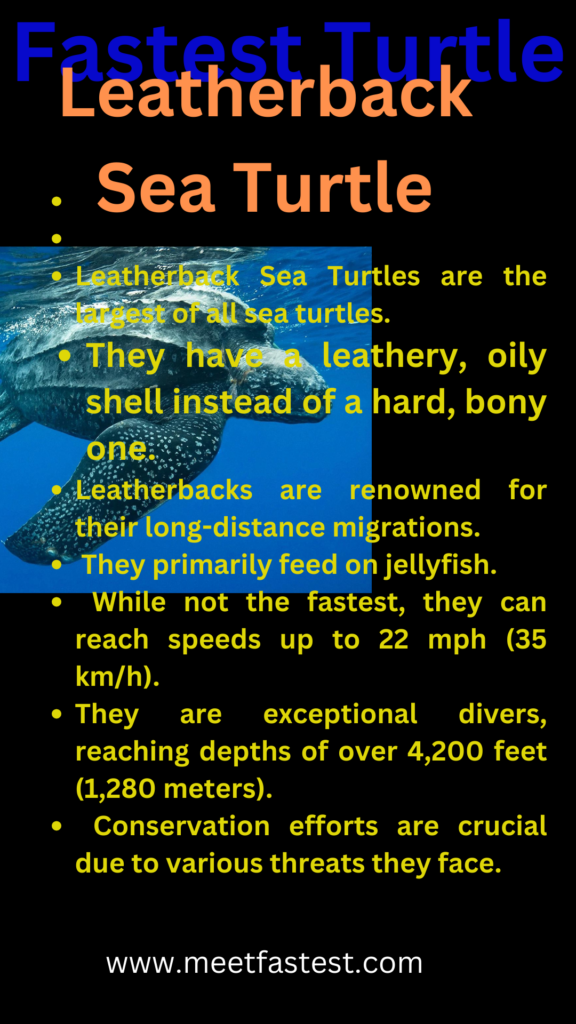Fastest turtle is the Leatherback Sea Turtle
Known scientifically as Dermochelys coriacea, the Leatherback holds the title of the fastest turtle.
Capable of reaching speeds up to 22 miles per hour (35 km/h) in the water.
In the vast blue expanse of the ocean, a giant glides through the water with surprising grace and speed.
This is the Leatherback Sea Turtle, the largest of all living turtles and a marvel of the marine world.

Unveiling the Leatherback Sea Turtle
This big turtle isn’t just speedy, it’s also really big. Some can grow over six feet long and weigh up to 2,000 pounds.
Unlike other sea turtles, the Leatherback doesn’t have a hard shell. Instead, it has a leathery shell with bony plates inside, which makes it feel different and bendy.
Anatomy of Speed
The Leatherback’s hydrodynamic body shape and powerful front flippers enable it to reach high speeds.
These flippers, which can grow up to 8.9 feet, propel the turtle through the water with forceful strokes.
The absence of a rigid shell reduces drag, allowing the Leatherback to cut through the water with ease.
A Global Voyager
Found in all tropical and subtropical oceans, Leatherbacks undertake lengthy migrations between feeding grounds and nesting sites, with some traveling more than 10,000 miles annually.
Their migratory patterns demonstrate their endurance and navigational skills.
The Leatherback’s Diet and Predation
Feeding primarily on jellyfish, Leatherbacks cover vast areas of the ocean in search of these gelatinous creatures.
Their speed enables them to chase down swift prey and escape from potential predators like sharks and killer whales.
The Role of Speed in Survival
Speed plays a crucial role in the reproductive success of Leatherbacks.
Female turtles must swiftly ascend to nesting beaches, lay their eggs, and return to the sea before falling prey to terrestrial predators.
Conservation Status: A Race Against Time
Classified as vulnerable, Leatherback Sea Turtles face numerous threats, from entanglement in fishing gear to ingesting plastic mistaken for jellyfish.
Conservation efforts are urgently needed to protect these magnificent creatures.
Also Read: Fastest American Jet Fighters: A Pinnacle of American Air Power
Human Efforts in Leatherback Conservation
Conservationists are working tirelessly to protect Leatherbacks through monitoring nesting sites.
Reducing bycatch in fisheries and raising public awareness about the species’ plight.
Conclusion:
The Leatherback’s Legacy
The Leatherback Sea Turtle’s speed is a natural wonder, highlighting the evolutionary marvels of the marine world.
Understanding these creatures reminds us of our responsibility to protect them and the oceans they inhabit.
The Leatherback’s legacy extends beyond being the fastest turtle
It reflects the resilience and beauty of life in our planet’s waters.
